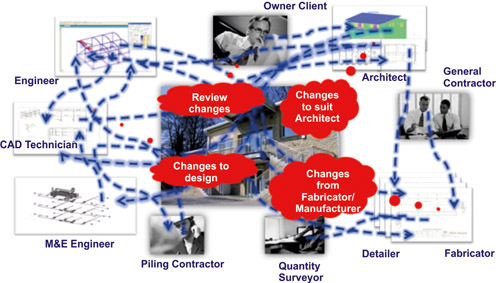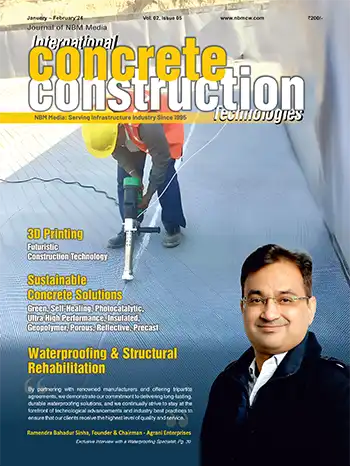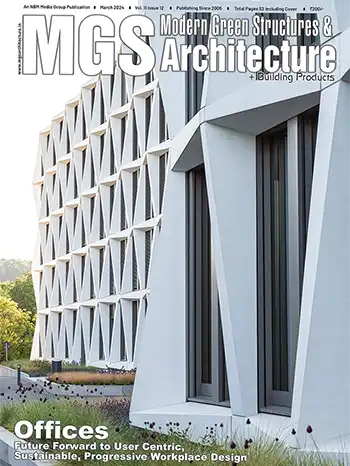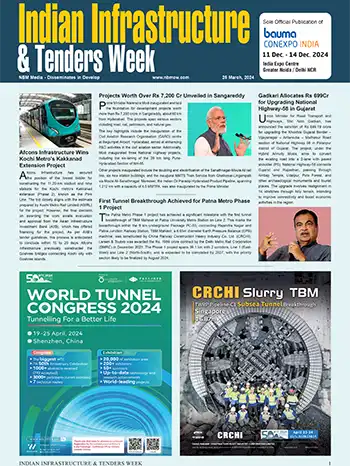BIM Approach to Construction Management
Infrastructure projects are booming
India is slowly but strongly emerging as the economic powerhouse of the new world order. Services and manufacturing sectors have primarily led the charge of India's growth engine. However without commensurate growth in infrastructure, India's growth may be severely stifled. Analysts estimate poor infrastructure shaves around 1 to 2 percentage points off India's economic growth. Prime Minister Manmohan Singh has said that building infrastructure will be crucial for India to achieve a growth rate of 10% in next few years. Government has planned USD 354 Billion investment in infrastructure for the 11th five year plan (FY 2007-2012), with another USD 150 Billion to come from the private sector.

Figure 1: Unorganized project collaboration
Construction industry is experiencing a boom due to the size and volume of infrastructure projects across airports, power and steel plants, railways, ports, roads & highways. Construction sector accounts for nearly 45% of the total investment in infrastructure and is expected to be the prime beneficiary of the surge in infrastructure investment in the near to medium term. As a consequence of this many tier one and tier two construction companies have huge order backlogs. There is tremendous pressure on them to deliver these projects on time and on cost, which is seldom achieved. Hence it is necessary for construction companies to adopt newer and efficient project management practices that can translate into higher savings and thus higher profits.
Current approach to managing construction projects
Indian construction industry is highly fragmented in nature and is resistant to adopting modern technologies related to construction planning and scheduling, material cost estimation, project monitoring and virtual collaboration between different parties. Many construction projects still follow a paper-based approach for design co-ordination on site, manual techniques for calculating steel and concrete quantities and disintegrated way of communication between the contractors on the project site and consultants back in the office. This leads to design and constructability issues, process delays due to site clashes and unclear lines of responsibilities thus ultimately resulting in wastage of resources and overall delay in project schedule.
India is slowly but strongly emerging as the economic powerhouse of the new world order. Services and manufacturing sectors have primarily led the charge of India's growth engine. However without commensurate growth in infrastructure, India's growth may be severely stifled. Analysts estimate poor infrastructure shaves around 1 to 2 percentage points off India's economic growth. Prime Minister Manmohan Singh has said that building infrastructure will be crucial for India to achieve a growth rate of 10% in next few years. Government has planned USD 354 Billion investment in infrastructure for the 11th five year plan (FY 2007-2012), with another USD 150 Billion to come from the private sector.

Figure 1: Unorganized project collaboration
Construction industry is experiencing a boom due to the size and volume of infrastructure projects across airports, power and steel plants, railways, ports, roads & highways. Construction sector accounts for nearly 45% of the total investment in infrastructure and is expected to be the prime beneficiary of the surge in infrastructure investment in the near to medium term. As a consequence of this many tier one and tier two construction companies have huge order backlogs. There is tremendous pressure on them to deliver these projects on time and on cost, which is seldom achieved. Hence it is necessary for construction companies to adopt newer and efficient project management practices that can translate into higher savings and thus higher profits.
Current approach to managing construction projects
Indian construction industry is highly fragmented in nature and is resistant to adopting modern technologies related to construction planning and scheduling, material cost estimation, project monitoring and virtual collaboration between different parties. Many construction projects still follow a paper-based approach for design co-ordination on site, manual techniques for calculating steel and concrete quantities and disintegrated way of communication between the contractors on the project site and consultants back in the office. This leads to design and constructability issues, process delays due to site clashes and unclear lines of responsibilities thus ultimately resulting in wastage of resources and overall delay in project schedule.
This is a premium article available exclusively for our subscribers.
If you are already a subscriber, please Login
If not, subscribe now and get access to well researched articles & reports on infrastructure construction, equipment & machinery, innovations & technology, project reports, case studies, and more. All this by simply paying just ₹200/- for a month of complete portal access, or a discounted rate of ₹1000/- for a full year of access.
NBM&CW July 2011


















